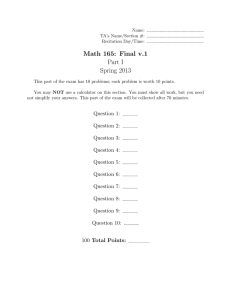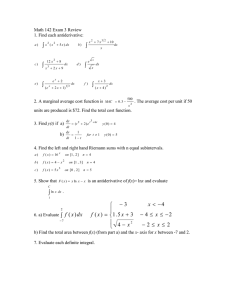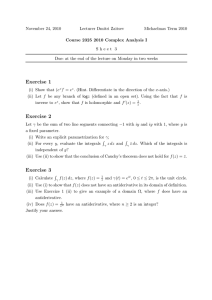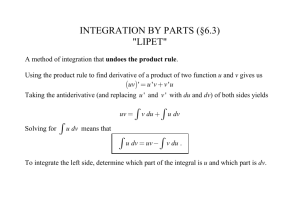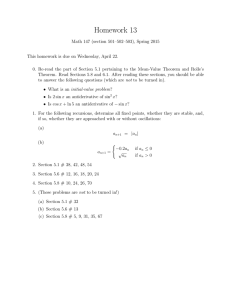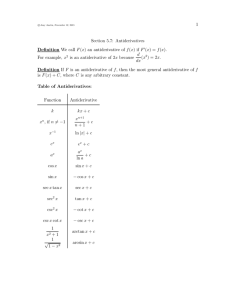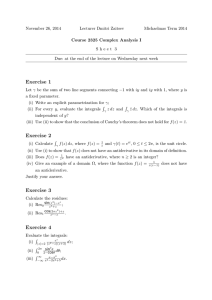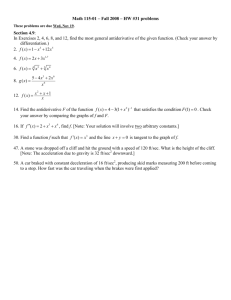10 Integration in one variable
advertisement
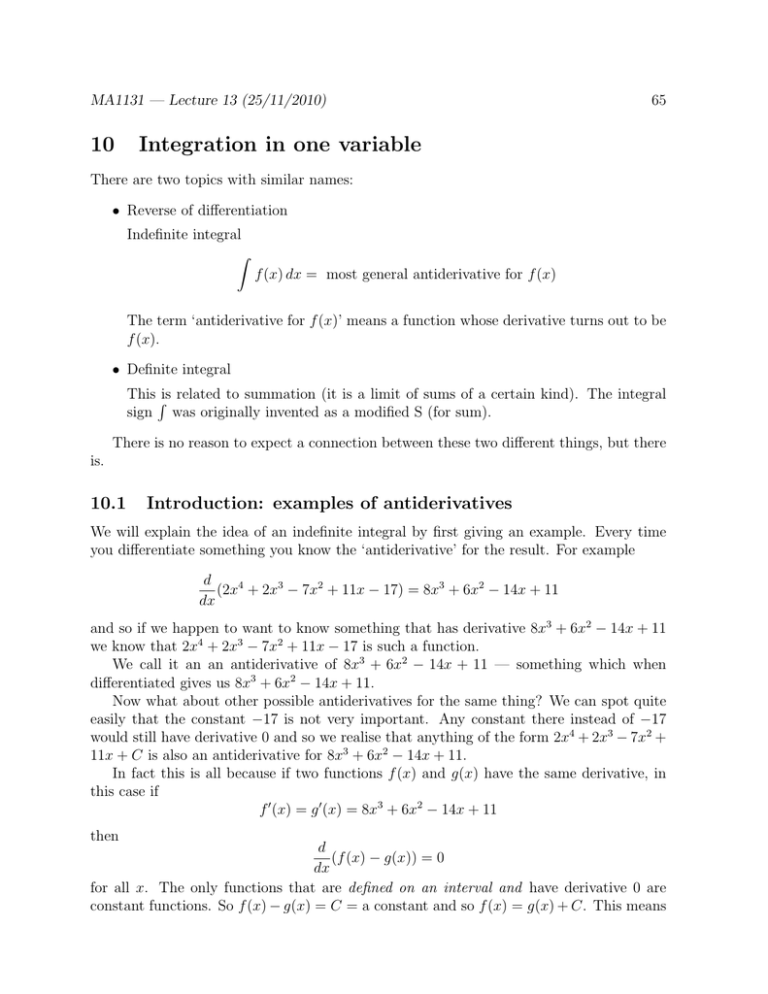
MA1131 — Lecture 13 (25/11/2010) 10 65 Integration in one variable There are two topics with similar names: • Reverse of differentiation Indefinite integral Z f (x) dx = most general antiderivative for f (x) The term ‘antiderivative for f (x)’ means a function whose derivative turns out to be f (x). • Definite integral This Ris related to summation (it is a limit of sums of a certain kind). The integral sign was originally invented as a modified S (for sum). There is no reason to expect a connection between these two different things, but there is. 10.1 Introduction: examples of antiderivatives We will explain the idea of an indefinite integral by first giving an example. Every time you differentiate something you know the ‘antiderivative’ for the result. For example d (2x4 + 2x3 − 7x2 + 11x − 17) = 8x3 + 6x2 − 14x + 11 dx and so if we happen to want to know something that has derivative 8x3 + 6x2 − 14x + 11 we know that 2x4 + 2x3 − 7x2 + 11x − 17 is such a function. We call it an an antiderivative of 8x3 + 6x2 − 14x + 11 — something which when differentiated gives us 8x3 + 6x2 − 14x + 11. Now what about other possible antiderivatives for the same thing? We can spot quite easily that the constant −17 is not very important. Any constant there instead of −17 would still have derivative 0 and so we realise that anything of the form 2x4 + 2x3 − 7x2 + 11x + C is also an antiderivative for 8x3 + 6x2 − 14x + 11. In fact this is all because if two functions f (x) and g(x) have the same derivative, in this case if f 0 (x) = g 0 (x) = 8x3 + 6x2 − 14x + 11 then d (f (x) − g(x)) = 0 dx for all x. The only functions that are defined on an interval and have derivative 0 are constant functions. So f (x) − g(x) = C = a constant and so f (x) = g(x) + C. This means MA1131 — Lecture 13 (25/11/2010) 66 that if we find one antiderivative (in our example 2x4 + 2x3 − 7x2 + 11x − 17) for the given function (in our example 8x3 + 6x2 − 14x + 11) then the most general one is of the form 2x4 + 2x3 − 7x2 + 11x − 17 + C. Since C − 17 is another constant we can write Z 8x3 + 6x2 − 14x + 11 dx = 2x4 + 2x3 − 7x2 + 11x + C. (This assumes we are working on an interval, no gaps. In this case the domain is the whole of R.) We can go about things a bit more systematically, by starting with the simplest rules for differentiation and turning them into rules for finding antiderivatives. R R d n (i) We know dx x = nxn−1 and so nxn−1 dx = xn +C. For example, 4x3 dx = x4 +C. We can use a little ingenuity to find that an antiderivative for xn−1 is n1 xn (as long as n 6= 0) and we can tidy this up to get the rule Z 1 xn dx = xn+1 + C (n 6= −1) n+1 R −1 It is perhaps interesting to see that we can’t immediately write down x dx = R 1/x dx. In fact the antiderivative for 1/x involves the natural logarithm function ln and is therefore a much more complicated thing that 1/x. For x > 0 we know (d/dx) ln x = 1/x. For x < 0, we can work out that 1 1 d ln(−x) = (−1) = dx −x x (x < 0). We can combine the cases x > 0 and x > 0 in one formula d 1 ln |x| = dx x (x 6= 0). That can be turned into an integration formula Z 1 dx = ln |x| + C x that is valid for either of the cases x > 0 or x < 0. Putting things together, we have Z ( xn dx = 1 xn+1 n+1 +C ln |x| + C if n 6= −1 for n = −1 A detail we should Rmention, is that when n < 0, xn is not well-behaved at x = 0. So the domain for xn dx is not an interval but two intervals x < 0 and x > 0. So, technically, the +C is not adequate in these cases to describe the ‘most general’ MA1131 — Lecture 13 (25/11/2010) 67 antiderivative. We could switch from one value of C to another as we pass x = 0 and still have a valid antiderivative (when n < 0). However, people rarely go into this and probably you almost never should encounter this in practice. Because things blow up at x = 0 there should not really be a practical problem where x > 0 and x < 0 are both valid (when dealing with xn and n < 0). d dv (ii) We know the derivative of a sum is the sum of the derivatives dx (u + v) = du + dx dx and so we can see that an antiderivative of a sum is the sum of the antiderivatives. Similarly for constant multiples. Using these rules, we can integrate all polynomials. For example Z 1 4 1 3 1 2 1 3 2 5x − 11x + 13x + 2 dx = 5 x − 11 x + 13 x +2 x +C 4 3 2 1 5 4 11 3 13 2 = x − x + x + 2x + C 4 3 2 (iii) From the rules for differentiating trigonometric functions d d d sin x = cos x, cos x = − sin x, tan x = sec2 x dx dx dx we can write down rules for integrating some Z Z Z cos x dx = sin x + C, sin x dx = − cos x + C, sec2 x dx = tan x + C With a little guesswork we can figure out some related integrals like Z cos 3x dx We might think of sin 3x as a possible antiderivative but d sin 3x = 3 cos 3x dx is 3 times what we want. Since 3 is a constant, we can divide across by it and we get Z 1 cos 3x dx = sin 3x + C 3 R However, there is no easy way to do sec x dx (you can find an antiderivative for sec x in the tables and verify that it works). We can write Z Z 1 sec x dx = dx cos x MA1131 — Lecture 13 (25/11/2010) 68 and we know how to integrate cos x but that does not help. The is no good quotient rule for antiderivatives. Unlike differentiation, where we can learn a small number of rules that are enough to differentiate almost any function we can easily write down, thereRare easy-looking functions hard to find. We have R where antiderivatives are quite R seen 1/x dx, more recently sec x dx and the example cos(x2 ) dx is one that is essentially impossible. It is not that there is no answer. There is an antiderivative but it is known that there is no way to write a finite formula for the antiderivative of cos(x2 ) using the familiar functions (powers, roots, fractions, trig functions, ln, ex ). 10.2 Z The Definite Integral b f (x) dx (read integral from a to b of the function f ). Answer is a number and does not a involve x. (The notation with the ‘running variable’ x is convenient.) Z b Graphical interpretation: f (x) dx is the area of the region in the plane bounded by a the graph y = f (x), the x-axis and the vertical lines x = a, x = b. (picture good for case f (x) ≥ 0) Problems: need a way to compute the area of such a shape. More fundamentally, need a definition of what you mean by the area. We will not explain the solutions to these problems in any detail here. That will be in the analysis module. Roughly speaking we start with approximations and then take a kind of limit. The idea for the approximation is to divide the are under the graph into many vertical strips. Here is a picture (though the number of strips is rather small here — only 8). MA1131 — Lecture 13 (25/11/2010) 69 The idea we work with then is the assumption that whatever the total area is, it should be the sum of the areas of these many strips. You might justifiably argue that seems to be no help at all, because each strip has a rather similar shape to the whole area — 3 straight line sides and a curvy top. Now comes the approximation step. It is not that hard to believe that if the strips are all really narrow, then they are approximately rectangles. We square the strips off something like this: That is we take a straight top at a level that cuts the graph within the strip. Of course it is an approximation that the area of the strip is roughly the area of the rectangle, but the advantage is that we know how to find the area of a rectangle — base × height. We do that calculation for each of our many strips and add up the results to get an approximation to the total area under the graph. Approximations are not good enough. We want to know what the actual area is. What we do is repeat the approximation scheme with many more strips that are narrower. And keep doing that. The limit of the answers we get for R b all these approximations makes sense and we use this limit of sums as the definition of a f (x) dx. MA1131 — Lecture 13 (25/11/2010) 70 There is a an attractive shortcut explanation about this, but one that is not so easy to make precise. Imagine you could divide the area under the graph into infinitely many infinitesimally thin strips, of widths dx. The strip from x to x + dx can be treated as a rectangle of width dx, height f (x) and so of area f (x) dx. Then ‘add’ up — which sort of Rb explains the notation a f (x) dx. A more accurate statement is that the above picture is only ok if f (x) ≥ 0 always (in a ≤ x ≤ b). If f (x) < 0 some or all of the time, the picture is this. Z b f (x) dx = (sum of areas where f (x) > 0) − (sum where f (x) < 0) a If we wanted to go into this in any detail, we would need to set up quite a lot of additional notation. Theorem 10.2.1 (Important Theorem). This limit process described above makes sense if f is continuous on the finite closed interval [a, b] (including end points). Proof of this is too hard for us. The idea of continuity has been explained in analysis by now. At points c ∈ (a, b) of the open interval, it means limx→c f (x) = f (c). But this is not accurate at the end points. There are very few examples where we could really compute the answer to this limiting process precisely even if we had set up all the notation involved. What is practical is to use a computer programme to work out the sum of the areas of the rectangles with a large number of narrow strips. This gives a practical way to find approximations to definite integrals. Example 10.2.2. Here is an example you could work out geometrically: Z 4 x + 2 dx 2 Remark 10.2.3. There is an amazing connection between definite integrals and differentiation, R b which we will now state. It comes about by considering not just one definite integral f (x) dx but a whole infinite number of them. a MA1131 — Lecture 13 (25/11/2010) For example, not just R2 0 f (x) dx but 71 Rx 0 f (t) dt for 0 ≤ x ≤ 2. Theorem 10.2.4 (Fundamental Theorem of Integral Calculus). Assume that y = f (x) is Z x continuous for a ≤ x ≤ b. Consider A(x) = f (t) dt for a ≤ x ≤ b. (A(x) is a new a function, built from f and definite integration.) Then A(x) is an antiderivative for f (that is A0 (x) = f (x) for a ≤ x ≤ b). In summary: Z x d f (t) dt = f (x) (a ≤ x ≤ b, if f continuous) dx a This is one part of the Fundamental theorem, or one way to state it. Corollary 10.2.5. There is an antiderivative for every continuous function f . Z x 3 d t Example 10.2.6. Find cos 8 dt dx t +1 a Solution: By the theorem Z x 3 t d x3 cos 8 dt = cos 8 dx t +1 x +1 a Theorem 10.2.7 (Other part of fundamental theorem). Assume that y = f (x) is continuous for a ≤ x ≤ b and suppose g(x) is an antiderivative for f (x) (that is g 0 (x) = f (x) for a ≤ x ≤ b). Then Z b f (x) dx = g(b) − g(a)= [g(x)]bx=a a Z 4 2x + 1 dx Example 10.2.8. Find 2 Solution: Antiderivative g(x) = x2 + x (since g 0 (x) = 2x + 1) and so Z 4 2x + 1 dx = [g(x)]4x=2 = [x2 + x]4x=2 = (42 + 4) − (22 + 2) = 14 2 MA1131 — Lecture 13 (25/11/2010) 72 Proof. (of A0 (x) = f (x) part of Fund. Thm.) Use first principles A(x + h) − A(x) A (x) = lim = lim h→0 h→0 h R x+h 0 Z x+h x f (t) dt h f (t) dt ∼ = f (x)h for h small. Thus limit is f (x). x Rb Proof. (of a f (x) dx R= g(b) − g(a) part) x We know A(x) = a f (t) dt is an antiderivative. Hence d (A(x) − g(x)) = f (x) − f (x) = 0. dx Thus A(x) − g(x) = c = const. Ra Use x = a to find constant: A(a) − g(a) = c. But A(a) = a f (t) dt = 0. Thus −g(a) = c and A(x) − g(x) = c = −g(a) for all x ∈ [a, b]. Use this for x = b to get A(b) − g(b) = −g(a), A(b) = g(b) − g(a), that is Z b f (t) dt = g(b) − g(a). a Notation 10.2.9. There is one thing (of many things) we have skimmed over. Rb When a > b, there is a convention that allows us to write a f (x) dx (for example R2 2 x + x dx) even though the limits are upside down. 3 By convention, the meaning for this is Z b Z a f (x) dx = − f (x) dx if a > b a MA1131 (R. Timoney) b November 24, 2010
